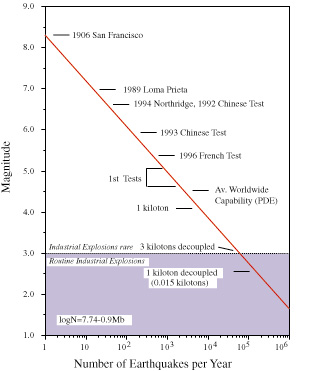geotimesheader
News
Notes
Science
Policy
Evasive
nuclear testing a misstated threat
Keeping nuclear tests a secret is difficult, say researchers who argue
that Senate leaders resorted to political stealth and misleading claims
about verification during last October’s debate over ratifying the Comprehensive
Nuclear Test Ban Treaty. One of the points of contention that has dogged
the treaty for 40 years, and some scientists say should be put to sleep,
has been the credibility of monitoring for evasive tests.
The international treaty would ban testing of nuclear weapons. During
last year’s debate, when the Senate failed to ratify the treaty, the majority
believed countries other than the United States might be capable of modernizing
their nuclear weapons through clandestine testing.
“It is possible to conduct a nuclear test with the intention of evading
systems designed to detect the explosion’s telltale seismic signature,”
said Senate Majority Leader Trent Lott on Oct. 8, 1999. Lott argued that
the U.S. government’s Arms Control Intelligence Staff considered caverns
dug in hard rock salt places where tests would be muffled to the outside
world — a technique known as decoupling or, more simply, the big-hole technique.
“Claims in the Senate debate about decoupling were either false or greatly
exaggerated,” says seismologist Lynn Sykes of Lamont Doherty Earth Observatory.
Sykes and others presented their views May 31 at the spring meeting of
the American Geophysical Union.
Sykes compared the debate last year with the zeal surrounding decoupling
during the 1960s when Eisenhower’s first science advisor, James Killian,
stated in his memoirs: “The big-hole technique proved to be much more difficult
than expected by its advocates. … It was a bizarre concept, contrived as
part of a campaign to oppose any test ban.”
In 1964, a 5.3-kiloton test created a cavity 828 meters deep with a
mean radius of 16.7 meters in the Hattisberg, Miss., salt deposits. Two
years later, the crater buffered a 0.38-kiloton explosion code named the
“Sterling” test. The Sterling test remains as the only known successful
and fully decoupled nuclear explosion, Sykes says.
A one-kiloton explosion has as many calories of energy as 1,000 tons
of TNT and generates the equivalent of a magnitude-4 earthquake, says Greg
van der Vink of the Incorporated Research Institutions for Seismology (IRIS)
Consortium in Washington. “Less than 1 percent of the energy from a bomb
is transformed into seismic waves,” he says. “Mostly it turns into heat
that vaporizes into the air and melts rock. Relatively little is actually
generating a seismic wave.”
| To fully cloak a nuclear test from the International Monitoring System,
a cavity needs to keep radionuclides from escaping, dampen the seismic
waves and cushion the shock waves without overstressing the rock. With
all its cracks and deformation, hard rock is simply not up to the job,
Sykes says. But hydrologic mining of salt could pump out brine and create
a large cavern with no cracks or joints. Still, it would be difficult to
keep secret, he says.
It’s no small task: A five-kiloton explosion in salt would require a
cavity 43 meters in diameter, big enough to fit the Statue of Liberty.
Most of the land in India and Pakistan is too dry for solution mining and
disposal of brine in rivers can easily be detected by satellite images.
And less than 1 percent of the land in Russia has salt, Sykes says.
Still, politicians express concern that five- to 10-kiloton testing
could be muffled in cavities in Russia or China and made to look like smaller
explosions, or even masked entirely. Should that ever occur, “it would
indicate they’re engaging in nuclear modernization and we’re not,” a senior
staff member on the Senate Foreign Relations Committee, who asked not to
be named, said at a recent Washington meeting.
Modernizing nuclear weapons vs. continuing with the ban on testing that
President George Bush initiated in 1992 is emerging as an underlying part
of the debate. The crux rests on whether or not the United States can maintain
its stockpile in working condition without testing. “We have encountered
problems we would have tested for in the past,” the staff member
said. “We would need to resume testing if problems reach above a certain
threshold, but to date those problems have not been identified. Will we
reach that threshold in the next administration? I believe we probably
will.” |

Seismic monitoring becomes more difficult as the size of the
explosion decreases. At lower magnitudes more earthquakes
occur, as do more legitimate industrial explosions, more
credible evasion scenarios and higher levels of naturally
occurring background noise. (PDE is the Preliminary
Determination of Epicenters, published by the U.S.
Geological Survey.) Greg van der Vink, IRIS. |
Christina Reed

